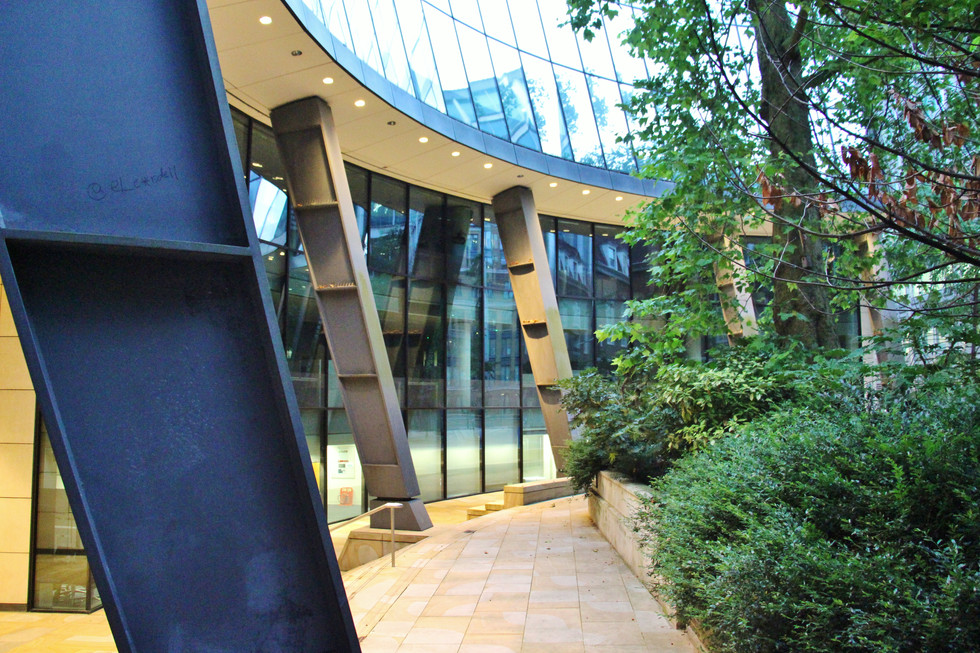Norman Foster vs the tree & Wren
- London On The Ground
- Sep 2, 2021
- 4 min read
Updated: Feb 13, 2022
A City building pays its respects to Christopher Wren and a London plane tree.

The City of London contains some of the most expensive real estate on the planet. Before the covid-19 pandemic, half a million people squeezed themselves into the Square Mile every day to work. Office space was scarce, most of the available land was developed and buildings climbed ever higher.
Yet the City has many instances of buildings that are constrained by greater, non-commercial imperatives.
Take 100 Wood Street, for example, a turn-of-the-millennium office designed by Norman Foster & Partners (next door to a building designed by Foster's arch rival, and former partner, Richard Rogers, but that's another story).

Elsewhere in the City, Lord Foster has designed much bigger, and less constrained, buildings.
His most famous City building, the Gherkin (officially 30 St Mary Axe, opened in 2004), was built tall and on a site that has plenty of space around it. His most recent City building, Bloomberg Place (winner of the Stirling Prize in 2018), covers a wide area, 3.2 acres (although the need to accommodate a Roman temple in its basement might have been a little constraining).
But 100 Wood Street had to deal with two major constraints laid down by the City of London Corporation (the Square Mile's local authority) during the planning process.
First, the front of his building could not present a façade onto Wood Street that was taller than the tower of St Alban, a nearby Grade II* listed building designed by the great Sir Christopher Wren.
Second, although there was plenty of space behind the building, Foster could not encroach on the garden of St Mary Staining and the London plane tree growing there.
Foster's solution at the front was to keep the Wood Street façade just shorter than St Alban, while creating roof space that curves up and away from the street to add height that does not loom over the tower.

At the back of 100 Wood Street, the building both leans away from the tree and curves around it. The slope of this rear façade allows space for the tree to grow and, happily, also brings more daylight into the offices.
The church of St Mary Staining was first mentioned in historical records in 1189 (the name 'Staining' is thought to refer to a family from Staines who held land in the area). The church was not rebuilt after its destruction in the Great Fire of London in 1666 and the site has remained an open space ever since.
The church of St Alban Wood Street was also destroyed in the Great Fire. Unlike its near neighbour, however, this church was rebuilt after the fire and completed in 1685 in a Gothic style only occasionally employed by Wren.
Incidentally, St Alban was the first British Christian martyr, beheaded by the Romans in the third or fourth century at Verulamium (modern day St Alban's) for harbouring a priest wanted by the Romans. There is a further Roman connection in that Wood Street was once the central north-south road of a fort constructed here in the early second century.
Wren's church was gutted by bombs dropped on the City in World War II. Most of the surrounding streets were flattened, but the tower of St Alban remained relatively unscathed. It was eventually converted into a private residence in the 1980s.
Other City church towers that are also now private residences are Christ Church Greyfriars and St Mary Somerset, while St Olave Jewry is a solicitors' office. The nave and aisles of Christ Church Greyfriars, destroyed in World War II and not rebuilt, are now a beautiful public garden. (The privately owned tower is currently on the market, with an asking price of £3.75 million.)
Further down Wood Street, at the junction with Cheapside, there is another small open space: the site of the former church of St Peter Westcheap, never rebuilt after the Great Fire. In its place stands a row of three of the original four late 17th century shops fronting onto Cheapside (see photo below, followed by an engraving of c1875 of the same view sourced from Wikipedia).
Where the churchyard used to be, there is a very old and tall London plane tree. The tree, thought to be at least 230 years old, was alluded to in a poem by William Wordsworth in 1797. Its protected status means that taller buildings are not allowed on this section of Cheapside.
More often than not, commercial imperatives triumph, especially in the City of London. It is even occasionally possible to buy pieces of City history for private use, such as the privately owned church towers.
The aftermath of the pandemic has relieved pressure on the City's office market for now, but office space is likely to remain at a premium in the Square Mile.
Nevertheless, other considerations also prevail. Regardless of the value of commercial property, churches, churchyards, gardens and trees are very important to the City of London Corporation.
Walks available for booking
For a schedule of forthcoming London On The Ground guided walks, please click here.













Comments